

Compact Muon Solenoid
LHC, CERN
| CMS-PAS-HIG-17-009 | ||
| Search for resonant pair production of Higgs bosons decaying to bottom quark-antiquark pairs in proton-proton collisions at 13 TeV | ||
| CMS Collaboration | ||
| November 2017 | ||
| Abstract: A search for a narrow-width resonance decaying into two Higgs bosons, each having a mass of 125 GeV and decaying into a bˉb pair, is presented. The search is performed using proton-proton collision data corresponding to an integrated luminosity of 35.9 fb−1 at √s= 13 TeV recorded by the CMS detector at the LHC. No evidence for a signal is observed and upper limits at a 95% confidence level on the production cross section times branching fraction for such a resonance decaying to two Higgs bosons and each of them to bˉb are set in the mass range from 260 to 1200 GeV. | ||
|
Links:
CDS record (PDF) ;
inSPIRE record ;
CADI line (restricted) ;
These preliminary results are superseded in this paper, JHEP 08 (2018) 152. The superseded preliminary plots can be found here. |
||
| Figures | |
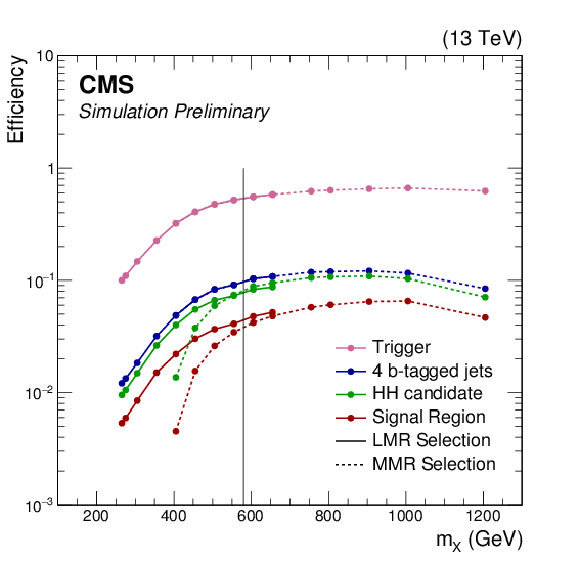
png pdf |
Figure 1:
The selection efficiency for simulated X→H(bˉb)H(bˉb) events (X is a spin-2 Bulk KK-Graviton) at different stages of the event selection for each mass hypothesis, for the low-mass region (solid) and the medium-mass region (dashed). The vertical line at 580 GeV shows corresponds to the transition between twe two selections. |
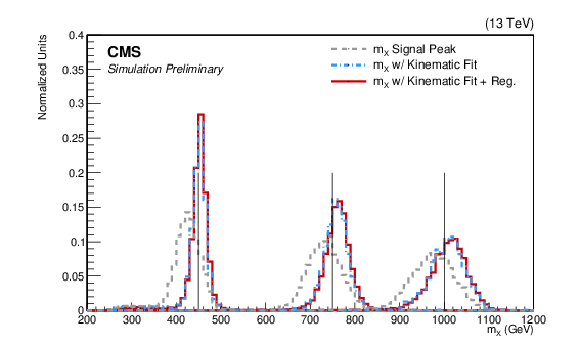
png pdf |
Figure 2:
The mX distribution of signal simulated events (spin-2 Bulk KK-Graviton) after the event selection criteria for the 450, 750 and 1000 GeV mass hypotheses, with and without the correction by the kinematic constraint to mH and the specific b-jet energy corrections. |

png pdf |
Figure 3:
Illustration of SR and SB in the (mH1, mH2) plane used to motivate and validate the parametric model for the QCD multijet background. The quantities mH1 and mH2 are the two reconstructed Higgs boson masses after b tagging and kinematic selections for data in medium-mass region. |
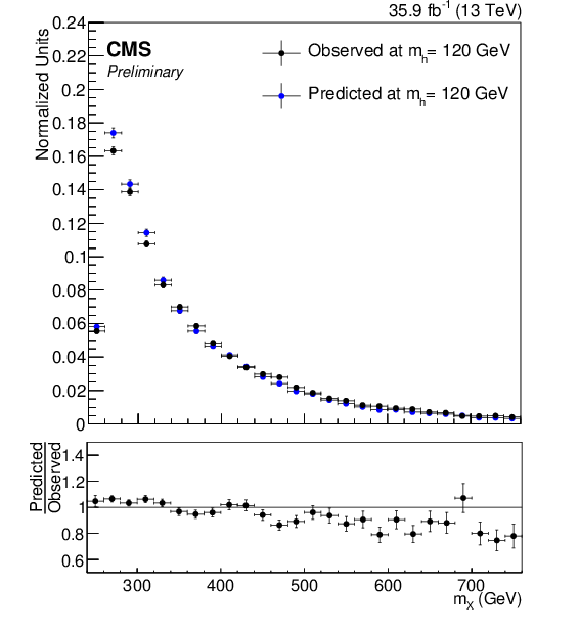
png pdf |
Figure 4:
The mX predicted (blue) distribution in data for the low-mass signal region in the lower fit range and the actual distribution in the signal region (black). |
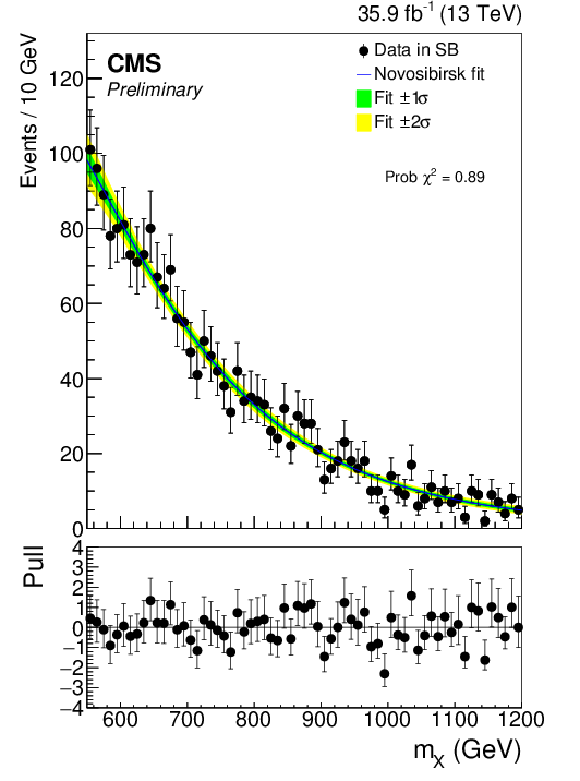
png pdf |
Figure 5:
The mX distribution in the sideband (SB) of the medium-mass region is presented in data. |
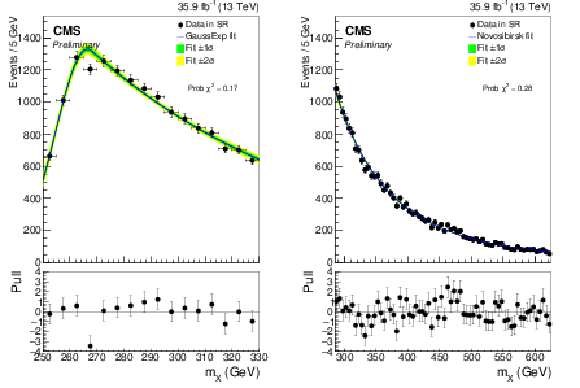
png pdf |
Figure 6:
The mX distributions after the LMR selections for prediction of the Signal Region. These distributions are fitted in the two sub-ranges with both nominal and alternative model ([250,330] GeV (left) [285,625] GeV (right)). A fit to the background-only hypothesis, which consists of the QCD multijet shape is shown. The shaded regions correspond to a ±1 and 2 σ variation of this parametrized form. |
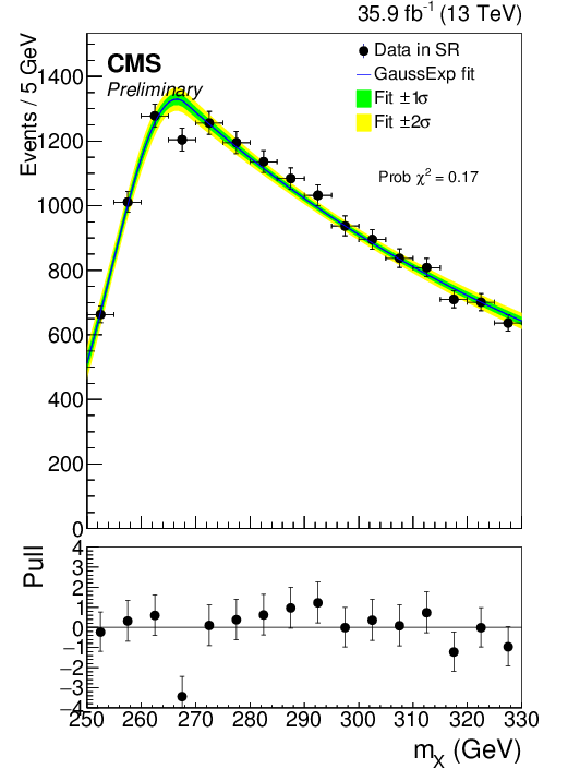
png pdf |
Figure 6-a:
The mX distributions after the LMR selections for prediction of the Signal Region. These distributions are fitted in the two sub-ranges with both nominal and alternative model ([250,330] GeV). A fit to the background-only hypothesis, which consists of the QCD multijet shape is shown. The shaded regions correspond to a ±1 and 2 σ variation of this parametrized form. |
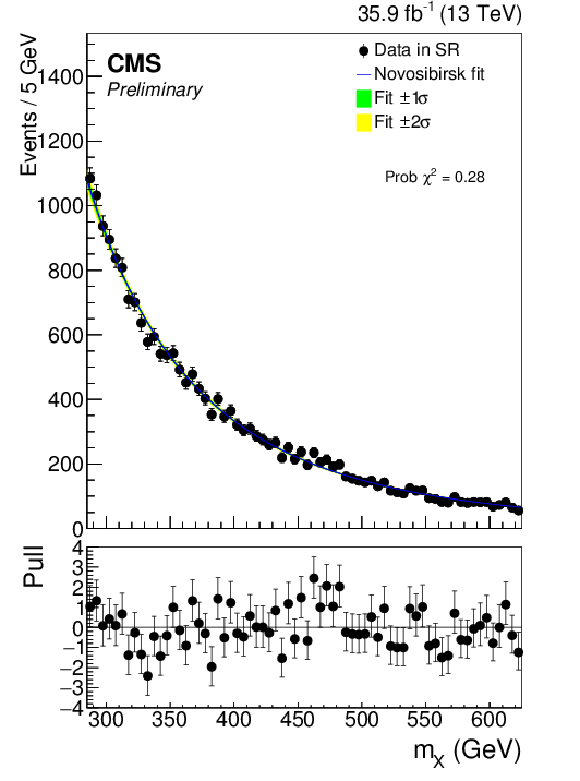
png pdf |
Figure 6-b:
The mX distributions after the LMR selections for prediction of the Signal Region. These distributions are fitted in the two sub-ranges with both nominal and alternative model ([285,625] GeV). A fit to the background-only hypothesis, which consists of the QCD multijet shape is shown. The shaded regions correspond to a ±1 and 2 σ variation of this parametrized form. |
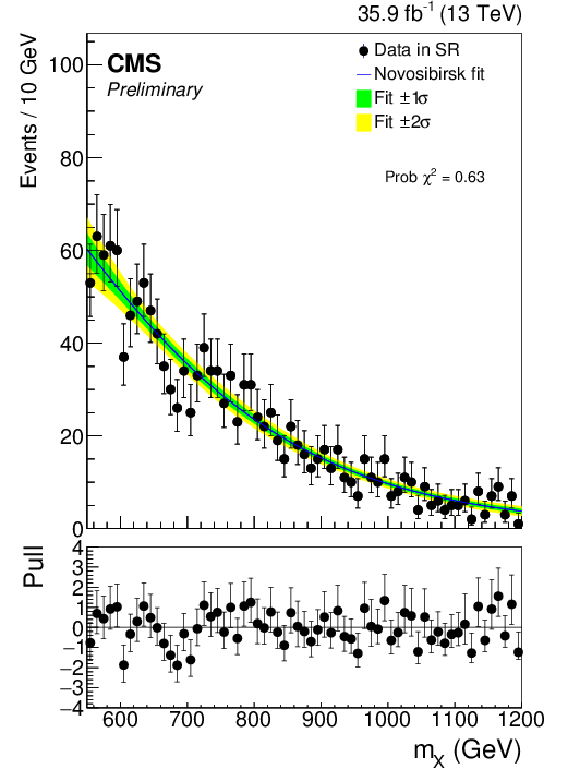
png pdf |
Figure 7:
The mX distribution of the QCD multijet component of the background in the Signal Region in data for the MMR. A fit to the background-only hypothesis, which consists of the QCD multijet shape is shown. The shaded regions correspond to a ±1 and 2 σ variation of this parametrized form. |
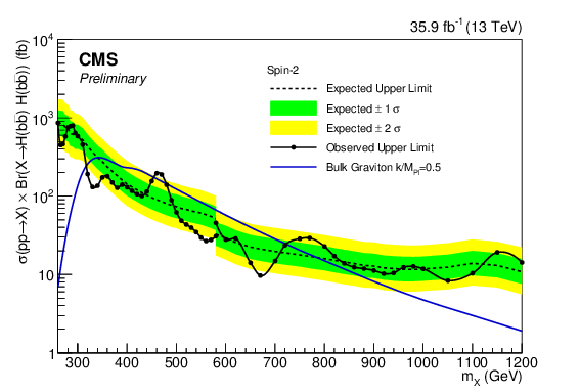
png pdf |
Figure 8:
The observed and expected upper limits on the cross section for a spin-2 resonance X→H(bˉb)H(bˉb) at a 95% confidence level using data corresponding to an integrated luminosity of 35.9 fb−1 at √s= 13 TeV using the asymptotic CLS method. Theoretical cross section for the Bulk KK-Graviton, with k/MPl= 0.5, kl= 35, decaying to four b jets via Higgs bosons is overlaid. The transition between LMR and MMR is based on the expected sensitivity, resulting in the observed discontinuity. |
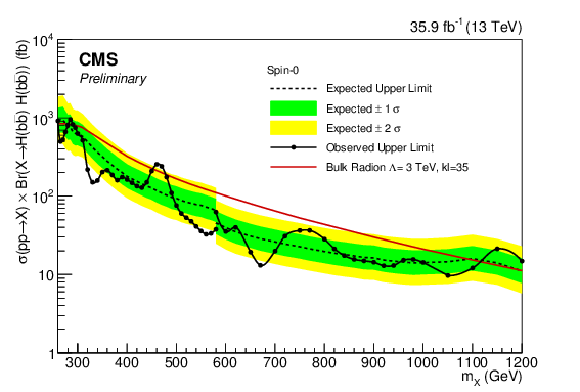
png pdf |
Figure 9:
The observed and expected upper limits on the cross section for a spin-0 resonance X→H(bˉb)H(bˉb) at a 95% confidence level using data corresponding to an integrated luminosity of 35.9 fb−1 at √s= 13 TeV using the asymptotic CLS method. Theoretical cross section for the radion, with λbda= 3 TeV, kl= 35, and no radion-Higgs boson mixing, decaying to four b jets via Higgs bosons is overlaid. The transition between LMR and MMR is based on the expected sensitivity, resulting in the observed discontinuity. |
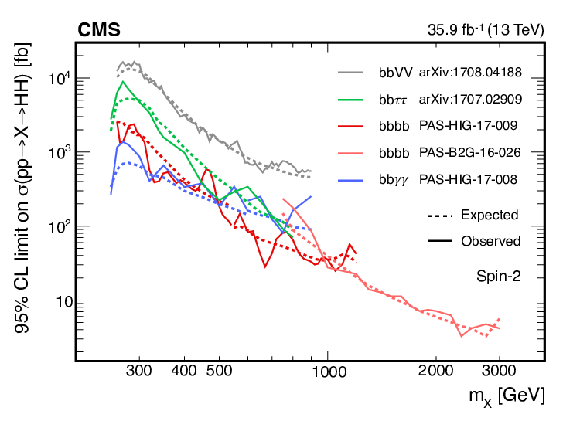
png pdf |
Figure 10:
Observed and expected 95% confidence level upper limits on the production cross section times branching fraction for a spin-2 resonance decaying to HH, using data corresponding to an integrated luminosity of 35.9 fb−1 at √s= 13 TeV. The results from different searches investigating various combinations of Higgs boson decay modes are reported. |
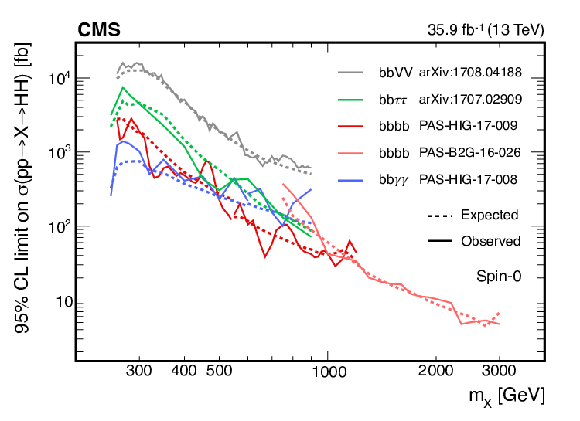
png pdf |
Figure 11:
Observed and expected 95% confidence level upper limits on the production cross section times branching fraction for a spin-0 resonance decaying to HH, using data corresponding to an integrated luminosity of 35.9 fb−1 at √s= 13 TeV. The results from different searches investigating various combinations of Higgs boson decay modes are reported. |
| Tables | |
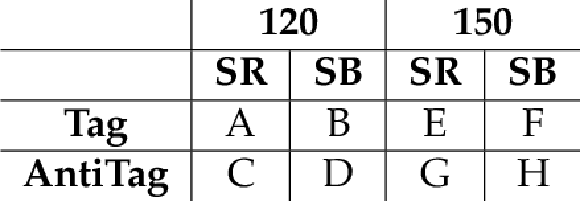
png pdf |
Table 1:
Definitions of the regions we use in the "ABCD" method to test the functional form as described in text. |

png pdf |
Table 2:
Impact of systematic uncertainties on the signal efficiencies in the low-mass region (LMR) and the medium-mass region (MMR). |
| Summary |
| A search for a narrow-width resonance decaying into two Higgs bosons, each having a mass of 125 GeV and decaying into a bˉb pair, is presented. The search is performed using proton-proton collision data corresponding to an integrated luminosity of 35.9 fb−1 at √s= 13 TeV recorded by the CMS detector at the LHC. No evidence for a signal is observed and upper limits at a 95% confidence level on the production cross section for such spin-0 and spin-2 resonances, in the mass range from 260 to 1200 GeV, are set. Using these results, a radion with decay constant of 3 TeV and a bulk graviton with k set to 0.5MPl are excluded at a 95% confidence level in the mass range from 300 to 1100 GeV and 320 to 720 GeV respectively. |
| References | ||||
| 1 | CMS Collaboration | Observation of a new boson at a mass of 125 GeV with the CMS experiment at the LHC | Physics Letters B 716 (2012) | |
| 2 | ATLAS Collaboration | Observation of a new particle in the search for the Standard Model Higgs boson with the ATLAS detector at the LHC | Physics Letters B 716 (2012) | |
| 3 | ATLAS, CMS Collaboration | Combined Measurement of the Higgs Boson Mass in pp Collisions at √s= 7 and 8 TeV with the ATLAS and CMS Experiments | PRL 114 (2015) 191803 | 1503.07589 |
| 4 | L. Randall and R. Sundrum | A large mass hierarchy from a small extra dimension | PRL 83 (1999) 3370 | hep-ph/9905221 |
| 5 | W. D. Goldberger and M. B. Wise | Modulus stabilization with bulk fields | PRL 83 (1999) 4922 | hep-ph/9907447 |
| 6 | O. DeWolfe, D. Z. Freedman, S. S. Gubser, and A. Karch | Modeling the fifth dimension with scalars and gravity | PRD 62 (2000) 046008 | hep-th/9909134 |
| 7 | C. Csaki, M. Graesser, L. Randall, and J. Terning | Cosmology of brane models with radion stabilization | PRD 62 (2000) 045015 | hep-ph/9911406 |
| 8 | H. Davoudiasl, J. L. Hewett, and T. G. Rizzo | Phenomenology of the Randall-Sundrum Gauge Hierarchy Model | PRL 84 (2000) 2080 | hep-ph/9909255 |
| 9 | C. Csaki, M. L. Graesser, and G. D. Kribs | Radion dynamics and electroweak physics | PRD 63 (2001) 065002 | hep-th/0008151 |
| 10 | K. Agashe, H. Davoudiasl, G. Perez, and A. Soni | Warped Gravitons at the LHC and Beyond | PRD 76 (2007) 036006 | hep-ph/0701186 |
| 11 | G. F. Giudice, R. Rattazzi, and J. D. Wells | Graviscalars from higher dimensional metrics and curvature Higgs mixing | NPB 595 (2001) 250 | hep-ph/0002178 |
| 12 | A. Oliveira | Gravity particles from Warped Extra Dimensions, a review. Part I - KK Graviton | Journal submission in preparation | 1404.0102 |
| 13 | CMS Collaboration | Search for resonant pair production of Higgs bosons decaying to two bottom quark-antiquark pairs in proton-proton collisions at 8 TeV | PLB749 (2015) 560--582 | CMS-HIG-14-013 1503.04114 |
| 14 | ATLAS Collaboration | Search for pair production of Higgs bosons in the bˉbbˉb final state using proton--proton collisions at √s= 13 TeV with the ATLAS detector | PRD94 (2016), no. 5, 052002 | 1606.04782 |
| 15 | ATLAS Collaboration | Search for Higgs boson pair production in the bˉbbˉb final state from pp collisions at √s= 8 TeVwith the ATLAS detector | EPJC75 (2015) 412 | 1506.00285 |
| 16 | CMS Collaboration | Search for Higgs boson pair production in events with two bottom quarks and two tau leptons in proton-proton collisions at sqrt(s) = 13 TeV | CMS-HIG-17-002 1707.02909 |
|
| 17 | CMS Collaboration | Search for two Higgs bosons in final states containing two photons and two bottom quarks in proton-proton collisions at 8 TeV | PRD94 (2016), no. 5, 052012 | CMS-HIG-13-032 1603.06896 |
| 18 | ATLAS Collaboration Collaboration | Search for higgs boson pair production in the γγb¯b final state using pp collision data at √s=8TeV from the atlas detector | PRL 114 (Feb, 2015) 081802 | |
| 19 | ATLAS Collaboration Collaboration | Searches for higgs boson pair production in the hh→bbττ, γγwW∗, γγbb, bbbb channels with the atlas detector | PRD 92 (Nov, 2015) 092004 | |
| 20 | CMS Collaboration | Search for resonant and nonresonant Higgs boson pair production in the bblnulnu final state in proton-proton collisions at sqrt(s) = 13 TeV | CMS-HIG-17-006 1708.04188 |
|
| 21 | CMS Collaboration | The CMS experiment at the CERN LHC | JINST 3 (2008) S08004 | CMS-00-001 |
| 22 | GEANT4 Collaboration | GEANT4 --- a simulation toolkit | NIMA 506 (2003) 250 | |
| 23 | M. Gouzevitch et al. | Scale-invariant resonance tagging in multijet events and new physics in higgs pair production | Journal of High Energy Physics 07 (2013) 148 | |
| 24 | J. Alwall et al. | The automated computation of tree-level and next-to-leading order differential cross sections, and their matching to parton shower simulations | JHEP 07 (2014) 079 | 1405.0301 |
| 25 | S. Carrazza, J. I. Latorre, J. Rojo, and G. Watt | A compression algorithm for the combination of PDF sets | EPJC 75 (2015) 474 | 1504.06469 |
| 26 | J. Butterworth et al. | PDF4LHC recommendations for LHC Run II | JPG 43 (2016) 023001 | 1510.03865 |
| 27 | S. Dulat et al. | The CT14 Global Analysis of Quantum Chromodynamics | PRD 93 (2015) 033006 | 1506.07443 |
| 28 | L. A. Harland-Lang, A. D. Martin, P. Motylinski, and R. S. Thorne | Parton distributions in the LHC era: MMHT 2014 PDFs | EPJC 75 (2015) 204 | 1412.3989 |
| 29 | NNPDF Collaboration | Parton distributions for the LHC Run II | JHEP 04 (2015) 040 | 1410.8849 |
| 30 | A. Buckley et al. | LHAPDF6: parton density access in the LHC precision era | EPJC 75 (2015) 132 | 1412.7420 |
| 31 | T. Sjostrand et al. | An Introduction to PYTHIA 8.2 | CPC 191 (2015) 159 | 1410.3012 |
| 32 | CMS Collaboration | Particle-flow reconstruction and global event description with the CMS detector | Submitted to JINST | CMS-PRF-14-001 1706.04965 |
| 33 | M. Cacciari, G. P. Salam and G. Soyez | The anti-kt jet clustering algorithm | Journal of High Energy Physics 04 (2008) 063 | |
| 34 | M. Cacciari, G. P. Salam, and G. Soyez | FastJet User Manual | EPJC72 (2012) 1896 | 1111.6097 |
| 35 | M. Cacciari and G. P. Salam | Dispelling the N3 myth for the kt jet-finder | PLB641 (2006) 57--61 | hep-ph/0512210 |
| 36 | CMS Collaboration | Determination of jet energy calibration and transverse momentum resolution in CMS | JINST 6 (2011) P11002 | CMS-JME-10-011 1107.4277 |
| 37 | CMS Collaboration | Heavy flavor identification at CMS with deep neural networks | CDS | |
| 38 | D. Guest et al. | Jet Flavor Classification in High-Energy Physics with Deep Neural Networks | PRD 94 (2016) 112002 | 1607.08633 |
| 39 | CMS Collaboration | Identification of b-quark jets with the CMS experiment | Journal of Instrumentation 8 (2013) P04013 | CMS-BTV-12-001 1211.4462 |
| 40 | CMS Collaboration | Identification of b quark jets at the CMS Experiment in the LHC Run 2 | CMS-PAS-BTV-15-001 | CMS-PAS-BTV-15-001 |
| 41 | CMS Collaboration | Search for a massive resonance decaying to a pair of Higgs bosons in the four b quark final state in proton-proton collisions at √s= 13 TeV | 1710.04960 | |
| 42 | CMS Collaboration | Search for the standard model Higgs boson produced in association with a W or a Z boson and decaying to bottom quarks | PRD89 (2014), no. 1, 012003 | CMS-HIG-13-012 1310.3687 |
| 43 | CMS Collaboration | Search for the standard model Higgs boson produced through vector boson fusion and decaying to b¯b | PRD92 (2015), no. 3, 032008 | CMS-HIG-14-004 1506.01010 |
| 44 | A. Hoecker et al. | TMVA: Toolkit for Multivariate Data Analysis | PoS ACAT (2007) 040 | physics/0703039 |
| 45 | Belle Collaboration | A detailed test of the CsI(Tl) calorimeter for BELLE with photon beams of energy between 20-MeV and 5.4-GeV | NIMA441 (2000) 401--426 | |
| 46 | CMS Collaboration | CMS Luminosity Measurement for the 2016 Data Taking Period | CMS-PAS-LUM-17-001 | CMS-PAS-LUM-17-001 |
| 47 | CMS Collaboration | Determination of jet energy calibration and transverse momentum resolution in cms | Journal of Instrumentation 6 (2011) | |
| 48 | A. L. Read | Presentation of search results: the cls technique | Journal of Physics G: Nuclear and Particle Physics 28 (2002) | |
| 49 | The ATLAS Collaboration, The CMS Collaboration, The LHC Higgs Combination Group Collaboration | Procedure for the LHC Higgs boson search combination in Summer 2011 | technical report, CERN, Geneva, Aug | |
| 50 | V. Barger and M. Ishida | Randall-Sundrum Reality at the LHC | PLB 709 (2012) | 1110.6452 |

|
Compact Muon Solenoid LHC, CERN |

|

|

|

|

|

|